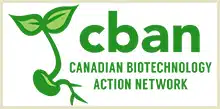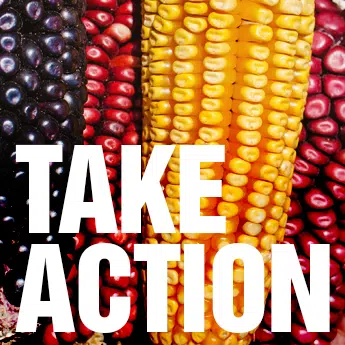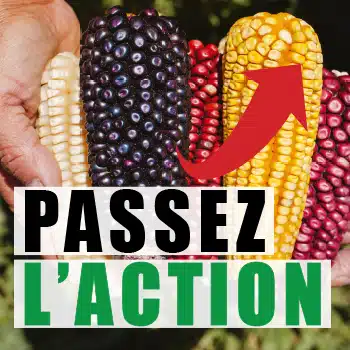Monsanto’s response to CBAN on SmartStax: Western Producer
(Click here to read the CBAN opinion piece that Monsanto is responding to)
Stacked Traits good for growers
Wester Producer, Opinion, November 5, 2009
by Trish Jordan and Brenda Harris
Jordan is public affairs director for Monsanto Canada. Harris is regulatory and government affairs manager for Dow AgroSciences Canada.
According to United Nations experts, worldwide agricultural production needs to double by 2050 to feed the expected 9.3 billion people on the planet.
Canadian agriculture can play an important role in meeting this rapidly escalating demand. Continued innovation is critical for producing more food with reduced use of non-renewable resources, in an economically profitable and environmentally sustainable manner, and without drastic increases in the amount of land subjected to the plow.
For planting in 2010, U.S. and Canadian farmers are looking forward to SmartStax corn, a new eight-way stacked corn product.
The new corn seed trait combination, developed jointly by Dow AgroSciences and Monsanto, will provide farmers with the most comprehensive insect and weed control available in the marketplace, while allowing farmers to significantly reduce their non-Bt corn refuge. …
SmartStax has passed regulatory reviews in Canada and the U.S., allowing it to be grown by farmers for use as food and feed. It has also passed regulatory muster in Taiwan and Japan allowing it to be imported for food and feed uses.
Regulatory approvals are also pending in other key nations around the world. … These approvals are necessary, since products like SmartStax cannot be grown or sold commercially until regulators conclude they meet their nation’s standards for protection of public and environmental health.
Despite these detailed national evaluations, certain non-governmental organizations are opposing the introduction of SmartStax and have criticized the Canadian regulatory process.
In particular, the Canadian Biotechnology Action Network opposes the very concept of crop biotechnology. It is hardly surprising that it vigorously objects to any new introductions of these products.
Based on their unfounded safety concerns, CBAN would have us believe our Canadian regulatory system is inadequate. Nothing could be further from the truth.
Despite CBAN’s claims, the fact remains that all biotechnology enhanced plants available to Canadian farmers have been approved based on extensive scientific testing and regulatory review by scientists from three government sections ( Health Canada, Novel Foods Section; and two departments within Canadian Food Inspection Agency, the Animal Feed Division, and the Biotechnology Environmental Release Assessment Unit) operating under Canada’s rigorous and internationally respected legislative and regulatory framework.
SmartStax is produced using conventional breeding methods to incorporate individual biotechnology-enhanced traits together into one plant. Each of SmartStax’s component traits has undergone this science-based regulatory review for food, feed and environmental safety, and each has been authorized for food, feed and cultivation uses in Canada.
These individual trait authorizations by Canadian regulators recognize that new varieties of corn are continually developed and that ongoing breeding is necessary to produce the seed that farmers grow.
Stacked products resulting from breeding two (or more) genetically modified parents do require notification to the CFIA. In the opinion of Canadian regulators, this notification is sufficient to allow them to determine if regulatory oversight requires additional information prior to assessing the product for commercialization.
Contrary to CBAN’s oft-made statements, the Codex Alimentarius has never stated that stacking biotechnology-enhanced traits poses increased risks compared to conventional products.
In the case of SmartStax, CFIA reviewed scientific insect resistance modeling data and a proposed insect resistance monitoring plan. CFIA has also scrutinized the evidence that commercial release of SmartStax will offer increased potential for insect pests to adapt to the Bt corn traits.
Consistent with independent expert opinions, CFIA concluded the combination of multiple Bt proteins will provide effective control even of insects with some ability to overcome one or more of the proteins. The reduced refuge size permitted for SmartStax recognizes this regulatory conclusion and increases the acreage over which these advantages can be realized.
Farmers have clearly seen that seed enhanced through agricultural biotechnology is safe. Genetically modified crops and their food ingredients have been present in a wide variety of Canadian food products for more than a decade with zero reliably documented evidence of safety concerns for people or animals.
More than one trillion meals containing biotech ingredients have been consumed throughout the world over the past decade with zero cases of documented harm to human or animal health.
International bodies including the World Health Organization and the European Food Safety Agency have extensively studied genetically modified foods and have declared them safe. A European Commission report based on studies valued at 70 million euros and conducted over 15 years concluded that GM crops did not pose “any new risks to human health or the environment beyond the usual uncertainties of conventional plant breeding. Indeed, the use of more precise technology and the greater regulatory scrutiny probably make them even safer than conventional plants and foods.” …
Farmers want the latest technologies to allow them to produce more, conserve more and address the world’s growing demand for food. Only through continued investment and innovation by many players will Canadian agriculture continue to prosper and compete in a growing world.
We should, and do have, rigorous oversight of products of biotechnology in this country. Canadian regulations are set up to protect the safety of the Canadian environment, food and feed supply, and to enable innovations that can enhance this goal.
Given the high regard the Canadian regulatory system has throughout the world, we are confident our regulators continue to meet this objective.






